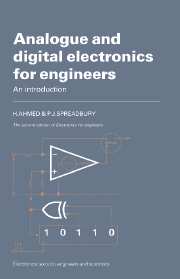Book contents
- Frontmatter
- Contents
- Preface to the second edition
- Preface to the first edition
- 1 Principles of amplifiers
- 2 The p–n junction and the field-effect transistor
- 3 The bipolar transistor
- 4 Operational amplifiers and linear integrated circuits
- 5 Negative feedback
- 6 Positive feedback and oscillators
- 7 Digital fundamentals
- 8 Digital circuits and applications
- Appendix A A list of useful textbooks
- Appendix B Device data and characteristics
- Answers to problems
- Index
7 - Digital fundamentals
Published online by Cambridge University Press: 05 June 2012
- Frontmatter
- Contents
- Preface to the second edition
- Preface to the first edition
- 1 Principles of amplifiers
- 2 The p–n junction and the field-effect transistor
- 3 The bipolar transistor
- 4 Operational amplifiers and linear integrated circuits
- 5 Negative feedback
- 6 Positive feedback and oscillators
- 7 Digital fundamentals
- 8 Digital circuits and applications
- Appendix A A list of useful textbooks
- Appendix B Device data and characteristics
- Answers to problems
- Index
Summary
Introduction
In chapters 2, 3 and 4, the capabilities of devices and integrated circuits have been explored for inputs which are continuous functions of time and where a linear output/input or ‘gain’ relation is usually sought.
Digital signals, where only two levels are considered, high or low, have the features introduced in § 1.10 and can be realised with gates. At the expense of some added complexity in circuitry, a system, such as a voltmeter or communication channel, and many other such pieces of equipment, can be built with a great capability for accuracy or for noise rejection compared to analogue methods. The basic circuit of a gate is both simple and cheap. From a description that, for some readers, should relate to school experiences with multivibrators, simple clocks or Venn diagrams, the methods of analysing and designing simple digital circuits are developed in this chapter.
Transistor as a switch – the simple inverter
The digital mode of operating a transistor is simpler than the analogue one described in earlier chapters. Figs. 7.1 (a) and 7.1(b) show a MOS and a bipolar transistor circuit respectively in which a change of input voltage controls the current put into the load, which may be a lamp, a bell, or a relay coil which needs to be energised. It is an important step to realise that, in digital circuits, the state between on and off is considered to occur only briefly between the normal conditions of fully on or off.
Information
- Type
- Chapter
- Information
- Analogue and Digital Electronics for EngineersAn Introduction, pp. 214 - 238Publisher: Cambridge University PressPrint publication year: 1984
